Goodbye to All Dat
The Parent Rap

One of the best things about having a child is watching them acquire, over years, the basic skills that make us human, and realizing, in fact, how hard fought the battle of acquiring them actually is. Watching a human learn how to sit, then crawl, then stand, then walk, makes seeing them finally run away from you all the more satisfying and heart-rending. And there are the lesser, but still impressive skills, the getting of spoons into mouths and the pencil holding. All of it, you’ll find, is quite impressive and immersive, if you’re really paying attention.
But nothing has impressed me quite so much as being a participant and beholder of my daughter Zelda learning to talk. From her first “dadas” and “mamas” to now, where full sentences tumble out of her three-year old motor mouth as if they were vomit or rainbows after a good hard rain, I have listened and repeated, documented and corrected.
Well, “corrected,” sometimes. Early in her speaking career I noticed that I delighted, as any parent does, in her mispronunciations. I kept a list. I followed along and I sometimes encouraged her, by altering my own English and using *her* words in its place. I knew that I was encouraging something selfishly, but I couldn’t stop myself.
Yegs
Yotion
Gwadawation
Wicklid
Phrysler Building
Dat
Dis
Deeze
Doze
Tanks
Diapuhur
iKommpudder
Copping Shart
Tink
I filled a notebook with a weird language all her own.
All kids do the best they can to acquire language. It’s an amazing feat, a truly overwhelming and awe-inducing state, to watch a kid learn how to speak in the space of three years. Now, Zelda is almost three and a half and she says things like, “the lyrics to this song are too quiet,” or, “I don’t like almond milk because it doesn’t taste good.” I’m proud of her, so proud, to see the tiny, well-spoken person she’s become.
But my heart aches to see the baby sloughed off of her like skin during a pedicure. A disgusting metaphor, I admit it, but it’s that transformative: all her rough edges are washing down the drain as she explains to me how water pipes work, or how her new classroom’s foundation is being built with cement. I listen to her sing “Hard Knock Life” and daily hear the words corrected: “Knop” has been replaced by “knock;” “empty velly life” is now “belly,” and and am weirdly thankful that she still occasionally says “hotton blankets” instead of cotton.
I am full to bursting when she corrects me. “What’s a hotton blanket?” I ask, just to hear her say the words. “COTTON, Mommy,” she said the other day as I died inside thinking about how dumb I must have sounded to her ever-evolving brain. “My God, does she think I don’t know the word cotton now?”
I vowed when Zelda was born never to baby talk to her, never to talk down to her. Her father did the same. It came naturally to us, to speak to her as if she were an everyday, normal person. And, probably at least partially because of that, she’s a very well-spoken, precocious little pile of bones. “I was a baby once, then I grew up. Everyone was a baby before,” she said at bedtime a few weeks back. I was so impressed that I asked her to tell me what happens next even though generally my policy is never to ask for more information at bedtime. “Then if you grow long enough, you get to be a baby again. That’s da life cycle,” she said, impressed with herself and her newly acquired term. “It is,” I said, not bothering to correct her about the details of “da life cycle.”
I don’t know if it’s satisfying, in this way, to all parents, to hear their child simply be wrong sometimes. But it is to me, still. The last vestiges of her babyhood are moving West like all the young tech bros, but a part of her is still here, on the Eastern seaboard with her parents, where we are better stocked with facts than she is. One day, I’m sure, she’ll know more than I do. But for now, I’m the only one keeping notes.
The Parent Rap is an endearing column about the fucked up and cruel world of parenting.
Go Ahead and Try to Title This Book; It Cannot Be Done
The quest for the titular pun
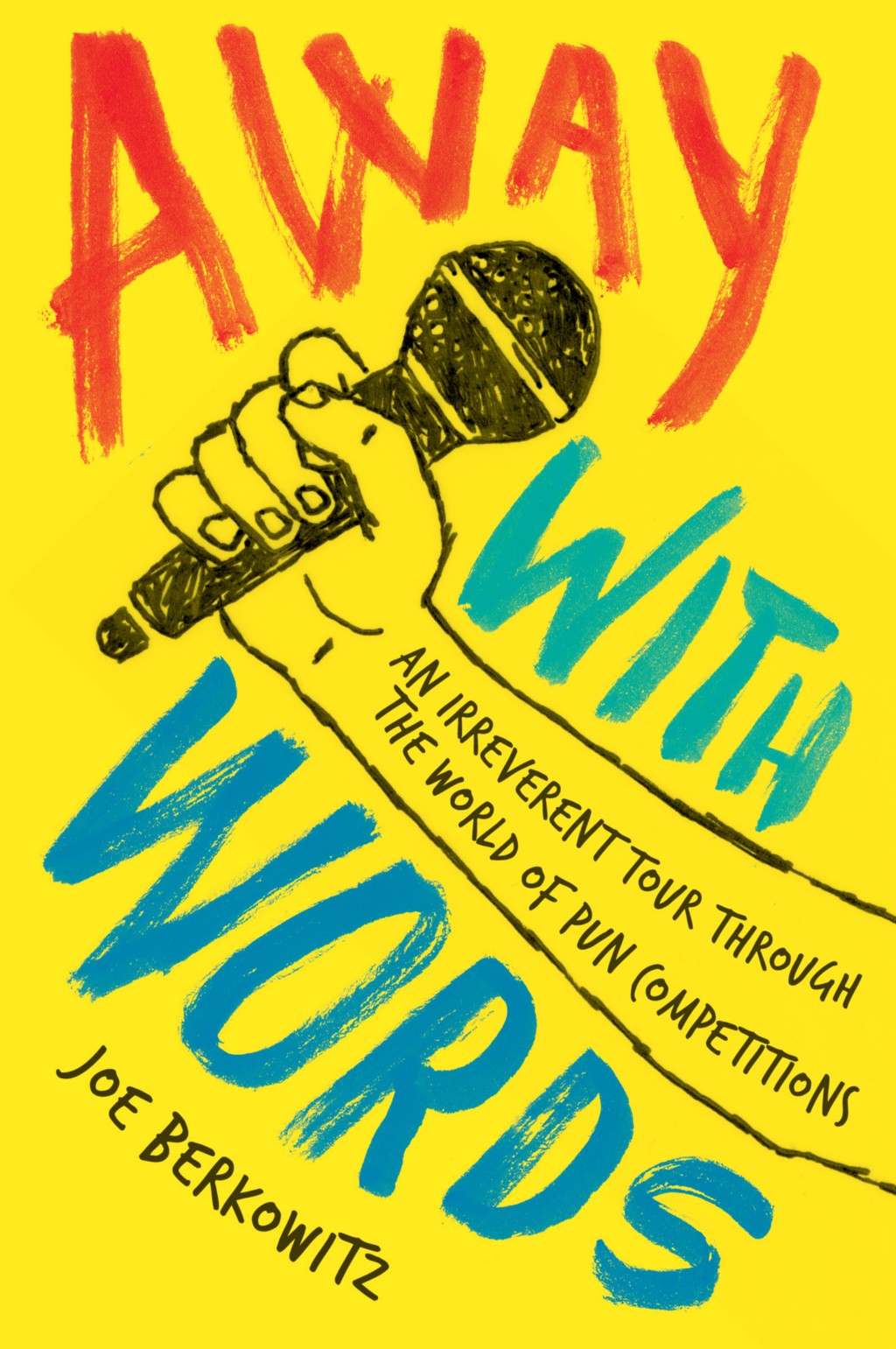
“When you know, you know.”
That’s the muddled advice marrieds offer — often unprompted — when single friends consider joining their ranks. The greatest trick the devil ever pulled was convincing us that if something sounds even vaguely like a zen koan it must be wisdom, and not budget fortune cookie claptrap. In this case, the wisdom suggests that if you’re not struck by the righteous lightning bolt of absolute certainty, keep waiting for it. (And waiting. And waiting some more.) Expecting an epiphany, however, has probably tainted more otherwise happy relationships than Scrabble, that stone-cold murderer of love. It’s also probably led to some really bad book titles, too.
Veteran authors are known to dispense the same trite advice as wedding-havers, only when they do, it’s directed at literary newbs bumbling toward a book title. “When you know, you know,” they’ll say, gazing into the middle distance as only a seasoned subject of author photos can. Although not much ties together the acts of proposing marriage and titling a book, they’re both ostensibly forever decisions. (Exceptions include when publishers sneakily change titles as a book hits paperback, and that time OJ Simpson’s If I Did It was virtually retitled I Did It for hilarious yet sad reasons.) When somebody gave me this advice as I was struggling to find a title for my book, the absence of some brain-exploding eureka moment haunted me, like a shy ghost who never shows its stupid, spectral face.
The problem was that this book is singularly resistant to easy titling. It’s about the burgeoning subculture of pun competitions — a real thing that really exists. The hypothetical title had a lot of heavy lifting to do. It was expected to: a) convey the idea of verbal sparring, b) give a sense of the tone, which was (hopefully) a hybrid of Mary Roach and Christopher Guest, c) be a pithy five words, max, since the subtitle would inevitably be kind of an info dump, and d) it had to have a pun in it. That’s a tall order. A really tall one. Tall enough to base dive off of, perhaps in order to escape, wingsuit-clad, from a really difficult task.
The title I landed on, many months later, is Away With Words. Not to break an arm patting myself on the back or anything, but, like, come on. Take a few minutes and try to top that. It cannot be done. This title fulfills all the above requirements, along with the stealth fifth requirement of not punning on the word ‘pun.’ And contrary to legend, the jackpot title announced itself neither as suddenly or as forcefully as the Kool-Aid Man. Instead, here’s a rough timeline of how it came to be seared upon the world and also the Library of Congress.
Fall 2015
The contract for the book identifies it with the cute placeholder, Puntitled. Here’s a little secret, though: that’s actually not a placeholder. Puntitled was my first best thought, which is more of a comment on the difficulty of solving this word-puzzle than the abject cleverness of Puntitled. The chief runner up was Pungilism, a portmanteau meant to evoke the idea of boxing with puns, but which in reality sounds more like a duel between differently foul odors. During the course of an interview for the book, when I told comedian Paul F. Tompkins I was considering going with Puntitled, he said, “You might want to keep considering.”
Other potentials from this period: Funny You Should Say That, Pun Fu, My Words Are Weapuns.
Spring 2016
For the next few months, the task of finding a title idly hung over the horizon like a final boss I’d inevitably have to battle. The elusive words might arrive at any moment, a fully formed verbal objet d’art; or, more likely, they would need to be wrestled out of the dark recesses of my brain with a death grip. As I neared completion on a first draft, a scant few formidable contenders entered the fray. The first was Punnish. It seemed to express both the lukewarm predilection for puns I’d started out with, and the spirit-crushing trauma of being around me after my immersion into the pun circuit. This title was deemed too negative, though. There was a half-hour soon after where I was 100% positive that A Game of Groans was the way to go, but that storm quickly passed before I realized it sounded like what MAD Magazine would definitely call its parody of the HBO boobs-and-dragons series. It had to go.
Other potentials from this period: Wordmongers, Words for Where, Idiom Addicts.
Fall 2016
As the drop-dead date on the title drew nearer, and remained as elusive as ever, it was time to get fucking serious about this. I started carving out time for title generation sessions. The first one yielded the following string of unsuitable suggestions, all with the word ‘pun’ in the title: Punintentional, And Then There Were Puns, An Army of Pun, A Confederacy of Punheads. What had I become? Who was this person polluting coffee shop energy with such sweaty thoughts?
Since misery loves company, I threw the problem out to the competitive punsters I’d met researching the book. I started a private Facebook thread for potential titles. What followed was a deluge of punny variations on classic literary tomes that was so profoundly off the mark, they might as well have posted to the dark web instead of my DMs. Chuckleberry Finn. Lord of the Zings. A Tale of Two Witties. All in all, the thread proves to be a lush, verdant garden of Not Helping. The burden was mine alone.
Away With Words happened at some point during the next dedicated title-generation sesh. It came out of a speed round, where I set a timer for five minutes, gave myself a quota of 20 ideas, and proceeded to scribble down anything at all that seemed relatively title-like. Many of the neighboring ideas abandoned the basic requirements. Spitting the Lotto Ticket, Flexing the Lexicon, and The Vernacular Factory were all equal possibilities. When I perused the completed list that day, Away With Words stood out, but I didn’t feel the certainty I’d been promised.
Other potentials from this period: Offhand Jesters, Killing the Filter, Laughing at Nothing.
The final selection was necessarily anticlimactic. I offered the top choices to my editor and her team, and Away With Words was the unanimous pick. I mean, of course it was; literally nothing else works. But when what in retrospect looks like an obvious winner first appeared, it was masquerading as just any other idea. It took some time for me to realize this one had staying power, like when a drunken tattoo concept — another forever decision — still retains its appeal in stark sobriety. The experience proved to me that waiting for a volcanic burst of utter certainty mostly leads to waiting around forever. ‘When you know, you know’ should probably be amended to something like ‘when you suspect you know, you might.’ I’m not sure that’s the one, though. Let me get back to you on that.
Away With Words (Harper Collins) is available now.
'Swan Lake' Is A Good Choice For Pride Month
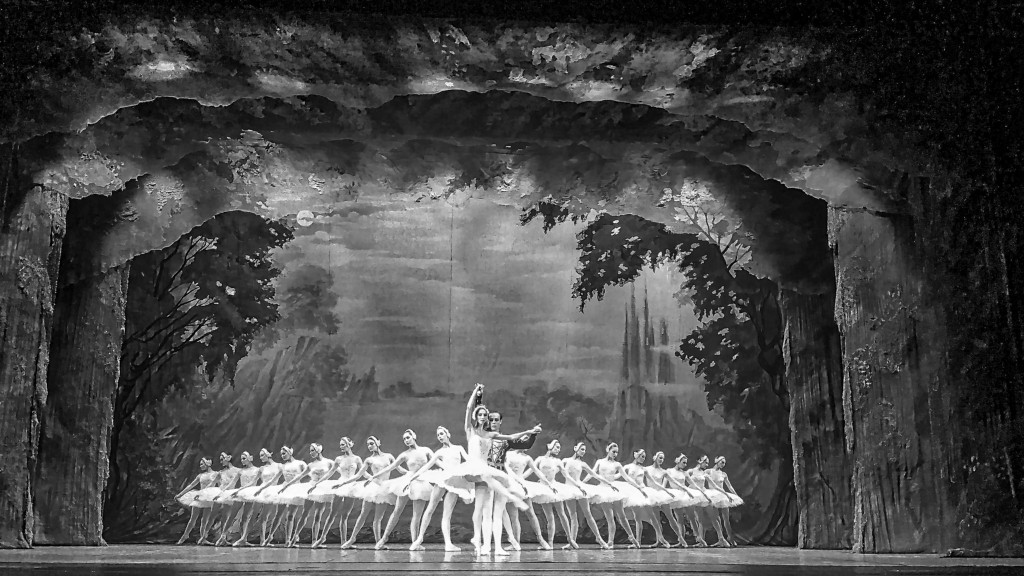
It’s June! It’s Pride Month! Happy Pride Month! Did you know Tchaikovsky was gay? You do now. Please don’t think that I sat down for two seconds and thought, “it’s Pride Month, who’s gay?” because that is certainly not how this column comes together (okay, sometimes it is, but). I was eager to revisit Tchaikovsky after the very long six months since I last wrote about him. I missed him. I did read that big book after. (Just wait until I miss Brahms.) And I also wanted to write about a ballet, and part of me thought it would be a good troll, just for fun, haha just kidding, to write about The Nutcracker because, I don’t know, it’s June, it’s 90 degrees in Chicago, it’s kinda funny. But that was stupid. Bad joke. So we’re doing Swan Lake this week, which works fine in terms of Pride Month because Natalie Portman and Mila Kunis kiss in my generation’s only cultural touchstone to Swan Lake. I wanted to title this piece “Swan Lake is gay” but it’s also not a good idea. I mean, I could have done it because I am gay, but it’s just not worth it. Okay, anyway.
Swan Lake premiered on March 4 (my mom’s birthday!!) in 1877 (not my mom’s birth year) to a tepid and disappointed audience. It was Tchaikovsky’s first ballet, and it was plagued with technical and design issues as well as an incompetent conductor. This, no doubt, sucks because Swan Lake is lovely, and it represents so much of what is good and memorable about Tchaikovsky’s music. It’s melodious and dramatic and not dissimilar from punching the air. It’s the type of music that makes you want to conduct to the air, beckoning more from an invisible orchestra. You know crazy people do that? (Me. I do that.)
The gist of Swan Lake (which in my head I often refer to as Swan Queen, which, we’ll get there) is that a carefree boyish prince named Siegfried* falls in love with a Swan Queen (see?) named Odette who is under a dumb curse that makes her a swan during the day but a beautiful woman at night. The curse was put into place by dingus owl-sorcerer named Von Rothbart who then introduces his mean daughter Odile into the mix, and Siegfried, like all bad men, starts to like her and breaks Odette’s heart. Odette goes to drown herself in — say it with me — Swan Lake, and then Siegfried is like, “I’m so sorry,” but he has already promised himself to Odile. Rather than marry the bad woman, Siegfried and Odette drown themselves and get married in Heaven. That’s just the swan life, baby!!! (I don’t know, honestly.)
Here’s the thing about Swan Lake. You can listen to the ballet in full (definitely recommended) but for time, I will recommend the suite which is sort of a “greatest hits” type of deal. If you like these six samplings, you can go back and enjoy the full two-and-a-half-hour ballet. The suite is essentially just what I want to listen to when I’m like, “Ah, jeez, what’s the deal with Swan Lake again?” A refresher, like how I only ever watch the first 45 minutes of Atonement and then shut it off.
But okay, regardless of how you listen, let’s get to the music of it: you definitely know the opening refrain. Famous strings, famous oboe, famous harp. There’s an air of mystery about the opening of Swan Lake (which is really just an overture), you know the type of tone, one that says, “Here’s a story from the past about a couple of idiots in love.” It’s frightening, though, parts of this melody, especially that big brassy theme at the end. It’s sharp and cutting, as if to warn, “Do not keep listening if you only want to have a good time.” Luckily for us, the whole thing is really a good time, teens drowning themselves and all.
The ballet really kicks into gear with the waltz. This is the melody that introduces Siegfried and gives you a sense of how playful and joyous he is. This is a boy’s waltz: purposeful, noble, not particularly delicate or whimsical so much as it is regulated fun like, I don’t know, baseball or something. It’s the piece of music in Swan Lake that gets me the most excited about what it is. I love the cascading woodwinds over the waltz melody. I love the big timpani rolls ushering each section. God, I even love the triangle in this piece.
The third part of Swan Lake is known as the Dance Of The Little Swans and it’s a 90-second mischievous interlude that portrays, God, I don’t know, a dance of little swans? These things are shockingly literal, believe me. There’s good oboe here, which I’m often quick to discount as one of the bad woodwinds (flute is still on the top of my list). The fourth part is simply a scenic melody, and its emphasis on the harp ought to just lift you literally onto a higher plane of existence. It’s gorgeous.
Swan Lake was Tchaikovsky’s first ballet, and it’s interesting to see how it set the tone for his other ballets. It’s such an achievement in melody and sound — colorful and passionate and playful. It reflected his self-confidence in his youth, before his personal troubles and depression and money problems. This was a man who struggled deeply with self-image and sexuality, and it’s perhaps his earliest music that has a semblance of confidence. I mean, listen to that violin solo at the 3:10 mark. This is pre-Tchaikovsky’s terrible marriage to Antonina Miliukova (who said she was a fan of his music but actually wasn’t, thus a good case for the necessity of the, “name three of their albums” meme) and it has the last gasp of someone whose work beyond may turn dark, unsettling. I’m spitballing, for sure, but this was written on the cusp of middle-age who was thinking and rethinking their legacy, both artistically and socially, and Swan Lake is one of a handful of pieces cobbled together from Tchaikovsky’s past.
The final two parts of the suite are the Danse Hongroise (Hungarian Dance — not HUNGRY DANCE like I typed into Google) and the Scène Finale (self-explanatory). The Hungarian Dance has always struck me as odd, but that’s perhaps because I know things like the Hungarian folk dances of Brahms and co., so I’m like, Tchaikovsky! Get a new thing! But the last minute of it sure is charming, and it does harken to that slightly more Central European style. Plus, I mean, I’m a sucker for all of this percussion. Does this not make you want to buy a pair of crash cymbals?
And then the end… I mean, this is a ballet that ends with teen suicide! It’s dark and intense and powerful and scary! Who among us has not attempted to drown ourselves in an aptly named lake to escape a curse? And it’s a little hard not to laugh at the end of Swan Lake because Black Swan really did ruin it. The ending, at least. “I was perfect,” I mean, Black Swan is a very cool-looking movie in which the script is insane and bad. I feel like I have to say that as a disclosure, which doesn’t necessarily justify how silly the ballet itself is, but that was the past. It still concludes, however, with the harp, Tchaikovsky’s final touch, to remind you he’s still behind it all.
*It will be impossible for you to guess how many times I typed his name as “Siegfriend”
Fran Hoepfner is a writer from Chicago. You can find a corresponding playlist for all of the pieces discussed in this column here.
Hank Youngman, "Now In Grey Marle"
I had a dream.
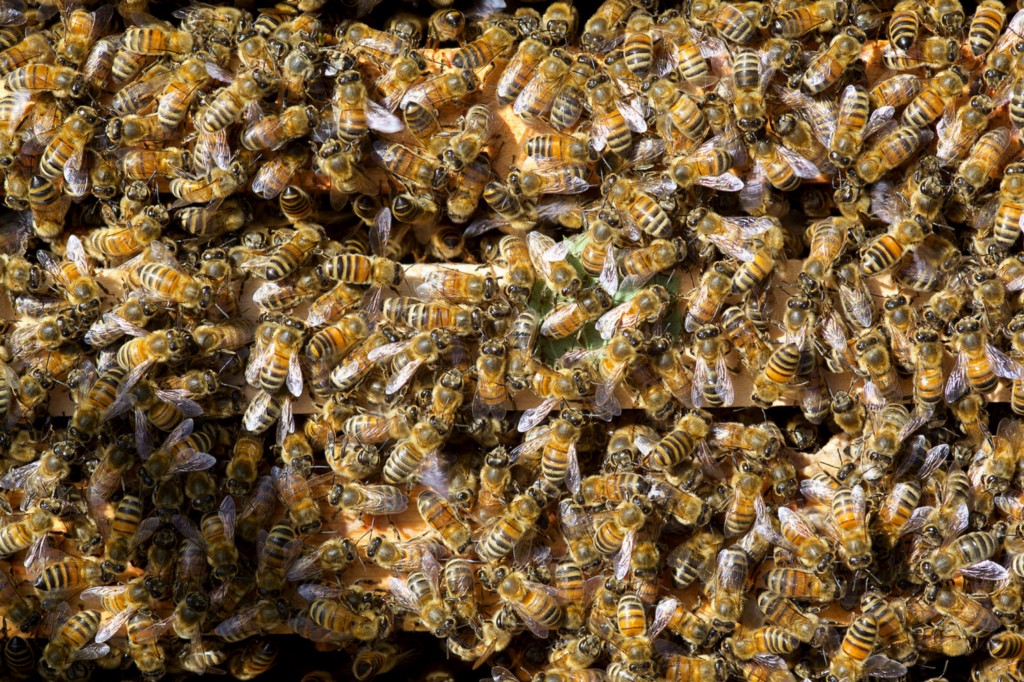
Last night I dreamed that God came down and gave a little speech. He told us that, after an extensive review, He could no longer justify all the resources He had originally allocated to humanity and He was going to restructure the organization of the dry land under the firmament to effect a more equitable and efficient expression of His creation, so that going forward dominion over every creeping thing that creepeth upon the earth would be assigned to the bees. He thanked us all for our efforts in His experiment thus far and was sorry that things hadn’t quite worked out the way we all had hoped, but He wished us well in our future endeavors, whatever those might be, and then He left us to negotiate our new world. Then all the stinging started. What does it mean? NOTHING. Dreams don’t mean anything. They’re a bunch of idiot thoughts your idiot brain jumbles up and pushes to the front of your mind to punish you for being asleep when it gets bored late at night and has no one to hang out with. Anyway, what dreams have you had lately? Tell us in the comments! Hahaha, j/k I don’t care. No one does. The only reason you listened to me talk about my idiot dream was you thought it might be going somewhere. Sucker! No one cares about dreams! Here, though, is something I care about very much: music. Enjoy.
New York City, June 13, 2017

★★★ The elevator was already full and sweltering before it stopped twice more to squeeze in sets of children and their grownup escorts. Out in the open, the sun pressed down and squeezed out sweat. Invisible rivers of different garbage smells flowed into each other on the air. The worst of the wrinkles in the lightweight cotton pants steamed their way out on the way to work. Jaywalking, it was hard to gauge speed and distance as slow-responding legs plodded in front of hazy traffic. The afternoon sky was so bright that the gray middles of clouds were blown out to nearly match the grimy blue around them. By late day, though, it was the clouds that were doing things to the sun, sending dark reverse glory rays up in the west. An ominous glow filled the vertical cleft between towering cloud masses, and from one of the piles a curling pseudopod extended itself.
No One Knows What To Expect From The New Queens Of The Stone Age
Except the name of the album: ‘Villains’
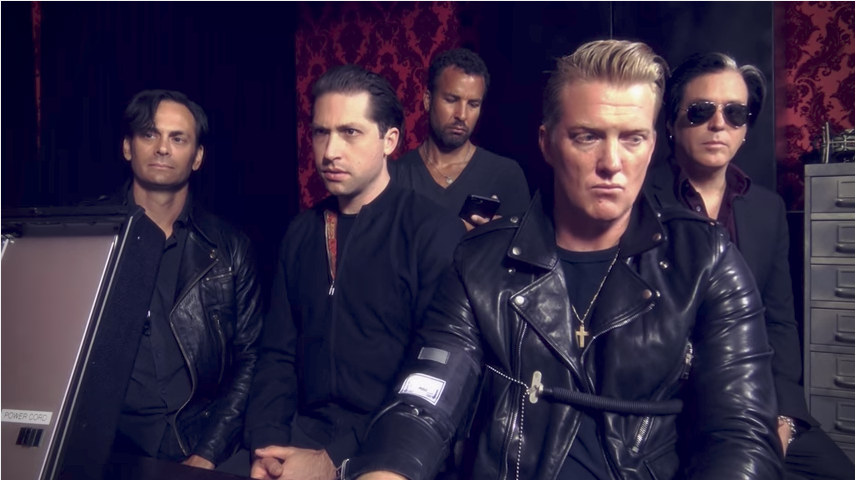
Queens of the Stone Age have revealed some further details for their much–hinted-at new record in a goofy short film that has them denying the information in a polygraph test, and failing. The trailer gives us a record title, Villains, and a glimpse of a new song. The generically titled “Feet Don’t Fail Me,” if we must compare it to something from frontman Josh Homme’s vast back catalogue, sounds similar to “Gunman,” a song from the tail end of the excellent and sonically challenging Them Crooked Vultures record.
The most surprising bit is that the record was produced by Mark Ronson, whom Homme briefly worked with when he contributed guitar parts on the most recent Lady Gaga album. Queens fans who prefer the earlier, more metal side of the band are likely suffering retina-detaching eyerolls at this news, but the more open-minded fan will be intrigued by what Ronson’s retro-modern production style might add to the band’s ever-evolving collage of sounds. Ronson’s fingerprint is already recognizable in the drum sound we hear in the brief clip, as is his sense of humor about being a famous DJ — see him at the turntable in the corner in a flash of disco lights.
Being a Queens fan has never been a passive concern; the listener must always engage and try to keep up with Homme’s point A to point Z synapses, and that tendency toward unpredictability continues here. The most notable absence in the video is a release date for the record, but whenever it does drop, one thing we can bet on is that it won’t sound like any of their previous releases, with Queens the only comfort zone is terra incognita.
John Dziuban is no longer a musician. Metal Minutiae is an occasional column on the decline of rock music.
The Agave Plant's Asparagus Death Fetish
The charismatic megaflora reproduces just once and dies.
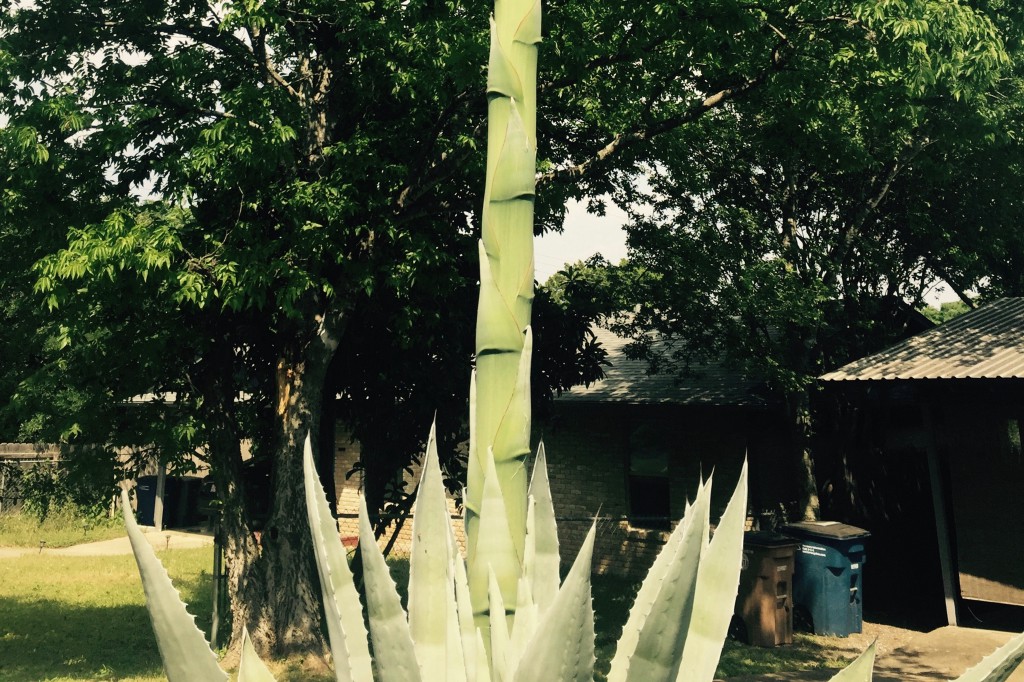
You never know when you’ll sprout a giant asparagus spear from your heart. This is what agave plants decide to do — out of nowhere — after sitting quietly in your yard for fifteen or twenty years. In Austin, Texas, agave plants are a static detail on the landscape — you find them arranged out front of your favorite mid-priced Mexican restaurant, trapped in a traffic island between a Bed Bath & Beyond and a Whataburger, groomed into oversized pineapples in grandma lawns. I have two of them in my yard and didn’t even realize it until one poked me in the leg.
The agave, beautiful though it may be, can lull you into a sense of complacency. One day you wander past the agave slumped against your mailbox like a drunk, and it’s waving a telephone poll–sized asparagus spear at the heavens. I’m not being metaphorical about European colonization in the Americas or anything with this asparagus thing. It looks like an asparagus spear, thick as a tree trunk, that could be served at a farm-to-table restaurant for gods — jutting out of the center of a lazy agave. You say aloud, “That’s weird.” And the guy who lives in a camper van in your neighbors’ driveway tells you, “Did you know agaves are related to the asparagus?”

Agave (genus Agave) is a species of 200 plants in the Asparagaceae family. Native to Mexico, the southwestern U.S., and the Caribbean. The most popular type of agave is most well known for its use in the production of tequila, mezcal, and agave nectar (a sweetener). The century plant, or maguey, species of agave is most commonly recognized as a landscape decoration. The agave’s leather-like leaves are distinctive for their spiny prickles. Agaves grow in a symmetrical rosette shape; some stay tight and spherical, while others become floppy and unwieldy. Under the right conditions an agave can grow up to 20 feet in diameter, about the size of a bouncy castle. Most are content to live in pots or decorate grandmas’ lawns. Beyond all that, agaves are a mass of contradictions.

Number one: An agave is not a cactus.
Often confused for a cactus because it is prickly and lives in the desert, I guess is the reasoning, agaves are not cacti — they’re a whole separate type of plant from a different clade. Like the aloe — which they are also not — agaves have fat leaves that thin out and are kinda spiny. Some agaves produce sap that you can use to make pulque — a fermented, alcoholic beverage that predates tequila by a few millennia. Mayahuel, the Nahuatl goddess of agave, served pulque from her 400 breasts. She dated Quetzalcoatl for a while. Mayahuel was not a cactus either.
Number two: Agaves lie about their age.
Though they are also known as century plants, most agaves only live for fifteen to thirty years. Opinions vary at the garden center, but you might be able to extend an agave’s life by trimming its lower leaves — keeping only the leaves near its top, or the center of its rosette. Freshly pruned, agaves look like over-sized supermarket pineapples. Whether or not this tactic will work is really for the agave in question to decide. Once an agave has sprouted flower buds from its agave trunk, its transformation into a whole new plant is complete — and all you can do is help get the plant’s affairs in order. No matter what you do, you’re looking at a plant that will outlive a house cat or two. Give or take.
Number three: Agaves are not asparaguses.
The agave is part of the asparagus family, and yet it is not an asparagus. Near death, agaves transform decades’ worth of energy into an enormous asparagus death spear, as tall and sturdy as a cell phone tower tree. With a big burst of high-weirdness, the agave makes its last stand. Like the agave, the common dinner-table asparagus is part of the plant group monocots, or monocotyledons. They have only one seed leaf (cotyledon). A lot of people have a lot to say about this subject. My favorite definition comes from Dave’s Garden:
A cotyledon is basically the first leaf that sprouts from a seed. Monocots have one, and dicots have two. Big deal. Some plants have one leaf to start their lives out with, and some have a pair. Seems like too little a difference to base an entire plant classification system upon. But then, I suppose we have to start somewhere.
So there you go.

Other monocots include orchids, most types of grass, palms, lilies, and the pineapple. Asparaguses are long-distance relations from Europe, Africa, and Asia.
An agave only reproduces once, right before it dies. The process of reproducing once — flowering, setting seeds — and dying is called monocarpy. Throughout its lifetime, an agave stores up all of its energy, waiting for the right time to spread its seeds and reproduce. It hunkers down, holding all of its energy in its heart, weathering years of drought and times of heavy rain — and when it rains in the desert, it’s like all the sky demons decided to dump out their above-ground pools at once. Then, for reasons of its own, the agave grows a massive, flowering asparagus spear out of its heart.
When the agave’s asparagus tree flowers, the agave hosts a pollination sex party. Nectar-feeding bats, ants, hawkmoths, beetles, and doves arrive to spread agave pollen and seeds. When it dies, the agave’s asparagus spear crashes to the ground, discarding seed pups willy-nilly to produce more agave plants. Or flatten a Subaru Outback in a South Austin cul-de-sac.
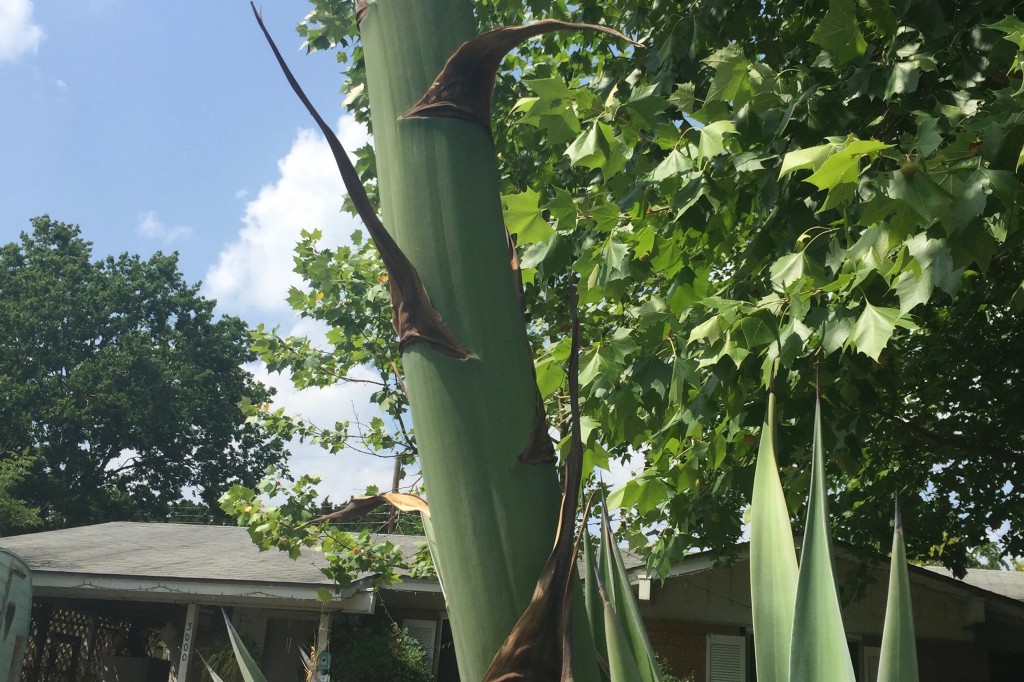
Clearing out a dead agave is a massive pain. In addition to their prickly leaves, agaves have dense root systems. If left to rot, the blue-gray leaves will become an unwieldy pile of white and crumbly plant decay, like a fluffle of bunniculas had an agave hoedown. Dead agave piles also seem to attract old Doritos bags. If a teenager can find sustenance in it, look for the discarded remnants in the nearest agave corpse. In my neighborhood, there’s a big dead one wrapped around a cactus that’s about to die that’s also wrapped around a mailbox. This same house is always putting out boxes of old karate trophies, like someone is going to take them.
Bats and agaves are believed to have evolved together. Long-nosed bats, which are an endangered species, feast on agave nectar. The bats roll around in the pollen grains. When they fly off to find more food, they transfer new pollen — promoting cross-fertilization. Here’s an explainer from Bats Magazine:
Both the plant and the bat benefit from this relationship, and therefore are said to be mutualists. Scientists believe that this association is the result of the coevolution of bats and plants and that the dependence is so strong that the plants could not reproduce without the intervention of the bats, which would starve to death if the plants were not present. This relationship seemingly is quite sensitive to disturbance.
Tequila production is one such disturbance because it endangers the sustainability of long-nosed bat populations and agaves. Tequila, which is produced from the heart of the agave azul, requires harvesting agaves before they flower. So, while the death of so many century plants in my neighborhood is tragic, it is also beautiful because it’s keeping a bunch of long-nosed bats from starving.
The web of life is a tangled thing and has connections everywhere. To our current understanding, there’s no other planet as rich with life as ours. Sure, there could be some phosphorescent fish swimming beneath the frozen seas of Europa or tardigrade-like critters clinging to water-vapor geyser on Ceres. If the agave’s asparagus death spear tells us anything, however, it’s that life is short and precious — quiet bonds exist between all living things — and it’s never too late to get weird.
Germans and Americans Both Love Their Damn Lawns
Deutschland über us.
I’ve finally figured out how we Americans can repair our newly fractured relationship with Germany: LAWN SUMMIT. And not a moment too soon: There otherwise seems to be little gemeinsam (guh-MINE-zamm), or in common, between us and the leaders of the free world. Germans are Jets, we are Sharks; they are Žižek, we are Chomsky; they are Bayern München, we are a country that doesn’t believe soccer is a real sport. AND YET: Despite the fact that it’s a blight on the ecosystem, a froofy holdover from the days when everyone wanted to pretend they lived on Downton goddamned Abbey, and a monumental waste of time, energy, water and space, both Germans and Americans can’t get enough of a lawn. Great.
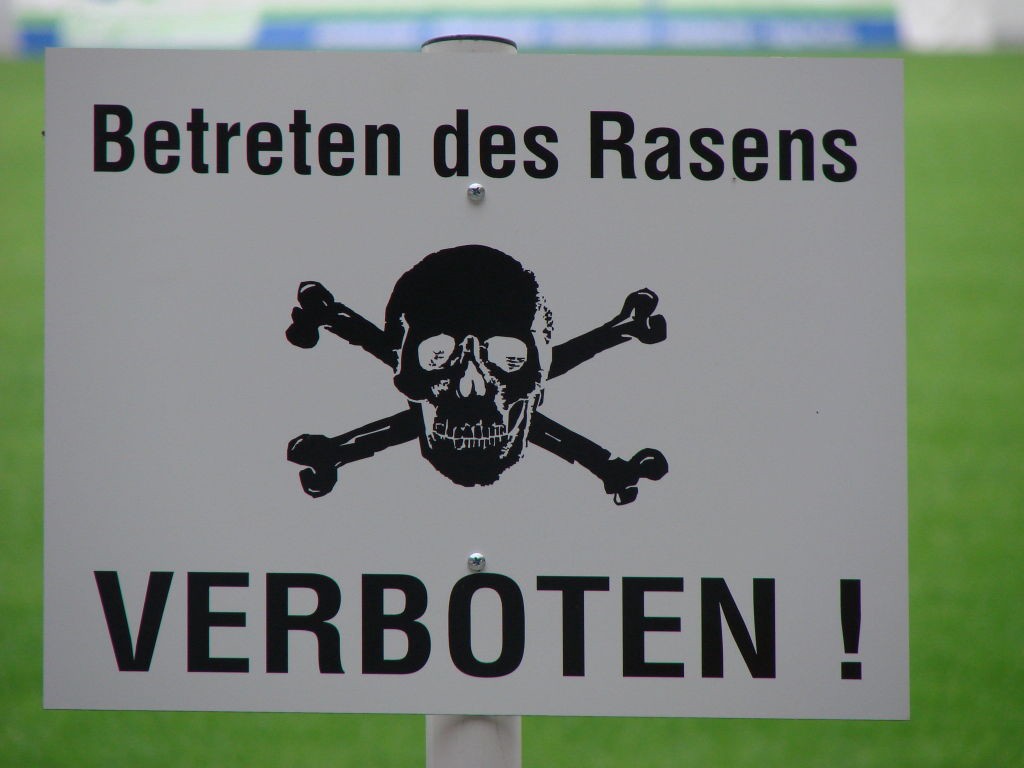
Or at least that’s the case according to Spiegel columnist Benjamin Schulz, who, after posting a slideshow of his own lawn-based ignominy and a plea for reader advice, received such a deluge of responses that, he says, “If there were a German Lawn Party, it would win a seat in the Bundestag for sure.”
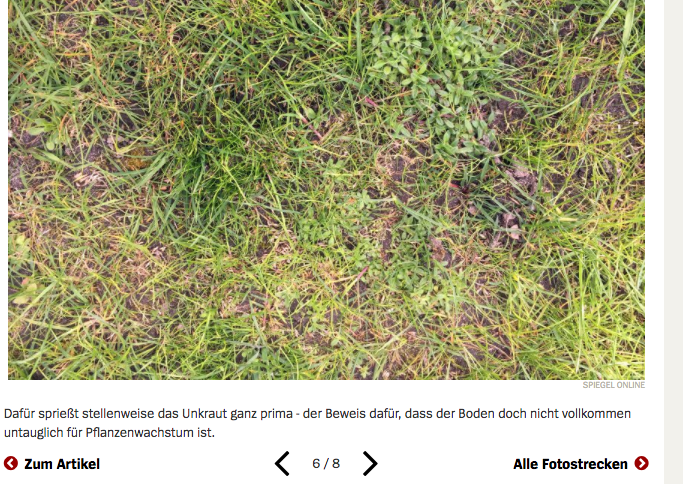
Of course, Schultz concedes, there’d be factions in the Lawn Party (where they’d perhaps hold fundraisers during lawn parties), “just like in the Greens.” The Realos faction (ray-AL-ohs) would insist that “weeds, moss and bald spots are inevitable” — with, by the by, the German word for “weeds” numbering among the best German words of all time: Unkraut (OON-krowt), literally “un-cabbage,” or a plant unfit for human consumption. (FUN FACT! This is actually a recurring construction in German, with fun examples such as Unwetter, or OON-vett-ah, “un-weather,” the word for “thunderstorms,” i.e. weather unfit for human interaction, and perhaps the best known example, Ungeziefer, or OON-guh-TSEE-fur, the untranslatable word for whatever the hell Kafka’s Gregor Samsa is, a hideous insect-like household pest unfit for Leviticus-style sacrifice unto the LORD.)
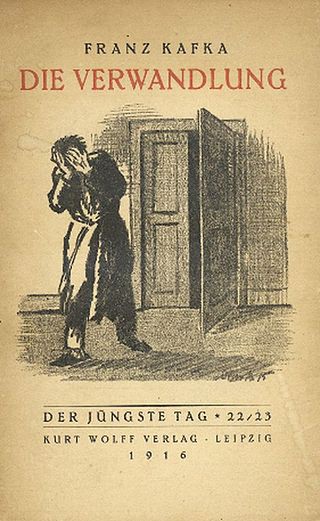
Meanwhile, back in the factions of the imaginary but dominant Lawn Party (and its imaginary but probably very fun lawn parties), we have the somewhat less prone to linguistic flights of fancy Fundis (FOON-dees), who would counter the Realos with the more Nietzschean belief that everyone can have a “perfect lawn” with enough “will and commitment.” The world of lawns seen from inside itself, apparently, is the Will to Uncabbage-Free Power, and nothing beyond that.
I tell you h’what, man: Germans’ obsession with the stupid patches of grass in front or behind their houses rivals only Hank Hill’s, and I guess we should be thankful for this tiny moment of intercultural understanding, even if it is about something terrible.
Germans, Hank, and even my mom; they’re all in lawn cahoots. I don’t know what it is about moms and lawns, by the way, but mine would be right at home in that Spiegel column. Some of Schulz’s readers, for example, recommended watering, at least once per week, one’s dog-poop farm and very reluctant Slip’n’Slide host (WHY HAVE A LAWN IF YOU CAN’T HAVE A SLIP’N’SLIDE, MOM???? WHY???).
While Schulz himself can’t see wasting all those liters of potential drinking water on a patch of overly-managed fake-wilderness that people use maybe three times a year tops (he bought a German thingy that traps rainwater; I’m sure it was expensive and will last until the year 3050), the same cannot be said of my mother, who, while everyone else on her block heeds the city’s “recommendation” to let one’s lawn die during the summer drought, defiantly runs the sprinklers so that her grandchildren, too, may experience their first bee stings while they enjoy a Crocodile Mile in their dreams.
Anyway, other important (and heavily debated) rules for German lawn care include the proper length to raze one’s Rasen, which is apparently “not shorter than three, and preferably four, centimeters,” and how often to fertilize, which is the second-best new German word I learned this week, düngen (DUUUUUENG-un), a verb that literally means “to dung,” ha ha ha ha ha ha ha ha ha ha. “No, Jürgen, you can’t have your allowance! You haven’t dunged the lawn.”
You might think, then, that Germans’ need for the world’s most perfect yard — the German word for which is Garten, which encompasses not only garden-gardens but courtyards, patios, gazebos, cupolas, koi ponds, mini-forests and the aforementioned lawn, Ungeziefer of green things — would be limited to those Germans who live where yards can be had, i.e. in the suburbs and the country.
You would be wrong.

Enter the Schrebergarten (SHRAY-bur-GAR-tun), the bizarre tiny enclave of yards and their adjoining huts that borders most every major German city. Originally parceled out in the 19th and 20th centuries for purposes of outdoor exercise and wartime food cultivation, these tiny, coveted patches of rented land passed down from generation to generation are home to gnomes, vegetables, flowers, even smaller lawns, and itty-bitty Häuschen (HOY-chen), or li’l houses, that generally contain kitchens, a little sitting area, maybe a bathroom, and zero beds because, as the wonderful blog Wunderbar! puts it, “one of the many hundreds of rules is that a Schrebergarten is non-residential, and rules are there to be obeyed.”
Germany Holidays: Schrebergärten, Germany’s suburban garden kingdoms
This, by the way, is where the US-German Lawn Summit would go to das Düngen, just like everything else our country touches. For just as Germans believe (and we most certainly do not) that there is a universal right to health care, they also believe there is a near-universal right to a goddamned lawn, even if you live in a seventh-floor walkup in a factory building not zoned for residence. As our American Unpräsident’s behavior slides further into King Lear territory, and I contemplate more seriously the thing Jews can do where we get German citizenship, I prepare for a better life in all ways but one: The lawns, it seems, are überall.
Bright side: At least I can found the Slip’n’Slide Faction of the Deutsche Rasen Partei.
Ass-Out Pants: Who Wore Them Better?
David Lee Roth vs. Prince
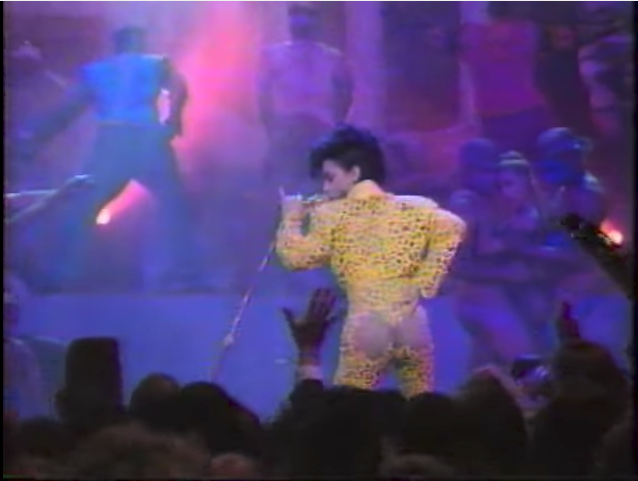

In 1986, David Lee Roth released his first full-length solo album, Eat ’Em and Smile. His 1985 Crazy From the Heat EP, recorded while he was still fronting Van Halen, hinted that he was on his way to going full drunk uncle at the wedding buffet, vibe-wise. Crazy featured four covers, including, of all things, a relatively by-the-book rendition of Louis Prima’s “Just a Gigolo/I Ain’t Got Nobody.” Do you realize how ridiculous it was to hear that on the radio in 1985? Hair metal was at its absolute peak, and DLR decided it was time to marry Aqua Net, spandex, cocaine, and guitar solos with Vegas lounge lizard antics and endless vaudevillian mugging and winking, high kicking his way across stadium stages with precision rarely seen away from Broadway, white-gloved jazz hands shimmering away on either side of his face.
Dismissing Van Halen’s music as “morose” (and who among us has not had a dark night of the soul, lying on the bedroom floor weeping and listening to “Hot For Teacher” on repeat?), DLR decided to strike out on his own once and for all, taking Van Halen’s lighting designer/creative director Pete Angelus with him. They called themselves The Fabulous Picasso Brothers, because, explained DLR, “fine art and pizza delivery — what we do for a living falls neatly in between.” He hired Steve Vai as his guitarist, who, like Eddie Van Halen, was recognized as a metal guitar virtuoso, having replaced Yngwie Malmsteen in Alcatrazz, for crying out loud, and worked alongside Frank Zappa as a teenager.
DLR has to have taken some of the inspiration for his Picasso Brothers jibber-jabber from Zappa; the liner notes for the Mothers of Invention’s album Freak Out! includes the choice quote “Freaking Out is a process whereby an individual casts off outmoded and restricting standards of thinking, dress, and social etiquette in order to express creatively his relationship to his immediate environment and the social structure as a whole.” Certainly kicking off one’s full-time solo career with “Yankee Rose,” an erotic ode to the Statue of Liberty, is casting off all sorts of things, including, as it turned out, any hesitation about memorializing one’s penchant for assless chaps.
For “Yankee Rose,” DLR went all-ass at once, both literally and figuratively. In embarking on this new, post-Van Halen project, he had a lot to prove, and he knew it. The video is already mind-boggling before the actual song even starts. “AND SO THE ADVENTURE BEGINS…!!!!” announces the title card, followed by a full minute and 39 seconds of a sort of comedy sketch that takes place in a convenience store and is a barrage of racist and sexist characters so over-the-top that the aforementioned drunk uncle at the wedding buffet would call them a bit much. Eventually, DLR himself appears in the embarrassingly ignorant face paint and headdress from the Eat ’Em and Smile cover, waving around a spear and hollering what sounds like another Zappa quote: “Gimme a bottle of anything…and a glazed donut….TO GO!”
After a smash cut to a signature spread eagle toe-touching leap off a drum riser, he prances across the stage, microphone held aloft triumphantly, mouth gaping back at the presumably stunned audience. His outfit consists of a fuchsia off-the-shoulders long sleeved crop top layered under a gold lame slingshot thong a la Borat and black and gold assless chaps with a large leather tassel providing a modicum of coverage, swinging like a proud show pony’s tail.
All at once, the ass is there and then it’s gone. During the next three and a half minutes, DLR shakes, thrusts, presents, wiggles, and rubs his now-clothed ass in every possible manner, but the first momentary glimpse of cheek is all we get.
This glimpse had a profound effect on me as a child. “I saw David Lee Roth’s new video for his song “Yankee Rose,”” reads my diary entry from July 21, 1986. “His buns show and his you-know-what bulges out of his pants! OH MY GOD! DLR IS A HUNK!” I was ten years old, but I knew that in 1986 math, buns + bulge equaled hunk. The adventure had certainly begun, but DLR would never quite surpass that ass-out moment. The Picasso Brothers movie he and Pete Angelus were planning with a “retinue of characters” fell through. None of his future albums would reach the heights of Eat ’Em and Smile. I never wrote about him in my diary again.

Stay with me now, and join me in remembering the other great breach rebirth, Prince’s “Gett Off” performance at the 1991 MTV Video Music Awards.
“Gett Off” was the first single off the then not yet released Diamonds and Pearls, Prince’s first album with the New Power Generation. Following the disappointment of both the movie and the album Graffiti Bridge, which was supposed to be a sequel to Purple Rain, the final remaining members of the Revolution had left. Prince had a lot to prove. Prince was no stranger to both partial and complete nudity, of course. His first three album covers literally move down his body — just his seemingly candlelit face, Afro, and a hint of collarbone on For You, majestically feathered hair, mustachioed face, and bare torso with tasteful-for-1979 chest hair on Prince, and the head-to-groin shot on Dirty Mind, for which he wore the unforgettable combo of studded leather jacket with office lady lapels, a bandana jauntily nestled over the aforementioned thatch of chest hair, and black bikini briefs with pubes creeping out over the top. (The photo is tastefully cropped, so there’s no you-know-what bulge to discuss in one’s diary.) Later, he’d go fully nude for the cover of Lovesexy, which he referred to as a gospel album, going so far as to “beseech the crowds to love God, over and over” during its tour. Nudity was never just an attention-getting device for Prince. It was sexual, yes, but it was spiritual, too.
Post-Graffiti Bridge, Prince had to get crowds to love HIM again. For his reintroduction back into the public eye, Prince had something special in mind. His costume designer, Stacia Lang, recalls that Prince’s secretary told her that she “better sit down” before sharing that “Prince wanted a costume with his BUTT OUT.” My favorite part of this story is Stacia providing two options for Prince, “one with more exposure, and one with less,” leading Prince to silently cross out the “more exposure” option. It’s impossible to imagine DLR showing subtle restraint within the realm of assless pants options; Prince knew what he was doing. Prince always knew what he was doing.
“Gett Off” opens with a scream, which was a departure for Prince, whose iconic screams usually fittingly occurred during his songs’ climaxes. At the VMAs, the scream rings out twice, once to kick off the performance, the stage crowded with the NPG as well as a mass of dancers, and then again by Prince himself as he appears at the 20-second mark. He dramatically throws himself to the floor and is covered by several men who eventually roll off of him as he rights himself with a classic jazz split. He was back.
His outfit is a sight to behold before the big reveal even takes place. It’s composed entirely of what appears to be laser cut openwork lace, calling to mind the ubiquitous Tord Boontje garlands of the early aughts. It’s also citron yellow, thus introducing Prince’s yellow phase, which would see him replacing purple as his signature color everywhere, including his house and car! Yellow and purple are complementary colors, falling opposite each other on the color wheel. Like I said, he always knew what he was doing.
There are several glimpses of ass as the performance progresses, but it is not the focal point. It’s hard to find a focal point because Prince is performing in front of what appears to be a massive, pulsating, torch-lit orgy. I didn’t write about this performance in my diary, but I did watch it as it happened, and I remember being truly shocked to my core, entirely titillated and confused by the line “something about a little box with a mirror and a tongue inside,” and terrified that my parents were going to wake up, discover me watching this spectacle, and forbid me to ever watch TV again.
Prince waits until the 2:39 mark to start the real ass work, coyly turning to the audience as he raps, quickly turning around again in a bit of burlesque, then timing the next turn and reveal to coincide perfectly with the line “let me show you baby I’m a talented boy.”
It is perfect; the audience screams; how could they not? For the rest of the performance, Prince revels in his ass, most extraordinarily when he turns around and grinds it at the audience in time to the line “Now move your big ass ‘round so I can work on that zipper, baby.”
Prince has a tiny, compact ass, but with that performance it became one of the most powerful and enduring asses of all time. In a bizarre coincidence, Van Halen also performed at the VMA’s that year. Now headed by Sammy Hagar, they sang a song about asses called “Poundcake.” It was trash.
Halo Top Flavors, Ranked
A Listicle Without Commentary
By Becca Laurie and Caroline Moss


- Birthday Cake
- Chocolate
- Strawberry
- Mint Chip
- Vanilla Bean
- Peanut Butter Cup
- Cookies & Cream
- Sea Salt Caramel
- S’mores
- Chocolate Chip Cookie Dough
- Pistachio
- Oatmeal Cookie
- Chocolate Mocha Chip
- Chocolate Almond Crunch
- Black Cherry
- Lemon Cake
- Red Velvet
